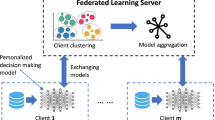Abstract
Mobile context modeling is a process of recognizing and reasoning about contexts and situations in a mobile environment, which is critical for the success of context-aware mobile services. While there are prior works on mobile context modeling, the use of unsupervised learning techniques for mobile context modeling is still under-explored. Indeed, unsupervised techniques have the ability to learn personalized contexts, which are difficult to be predefined. To that end, in this paper, we propose an unsupervised approach to modeling personalized contexts of mobile users. Along this line, we first segment the raw context data sequences of mobile users into context sessions where a context session contains a group of adjacent context records which are mutually similar and usually reflect the similar contexts. Then, we exploit two methods for mining personalized contexts from context sessions. The first method is to cluster context sessions and then to extract the frequent contextual feature-value pairs from context session clusters as contexts. The second method leverages topic models to learn personalized contexts in the form of probabilistic distributions of raw context data from the context sessions. Finally, experimental results on real-world data show that the proposed approach is efficient and effective for mining personalized contexts of mobile users.
Similar content being viewed by others
References
Abowd GD, Atkeson CG, Hong J et al (1997) Cyberguide: a mobile context-aware tour guide. Wirel Netw 3(5): 421–433
Aggarwal C (2011) A segment-based framework for modeling and mining data streams. Knowl Inf Syst. Online first, 2010-11-22
Anagnostopoulos C, Tsounis A, Hadjiefthymiades S (2007) Context awareness in mobile computing environments. Wirel Pers Commun 42(3): 445–464
Azzopardi L, Girolami M, Van Risjbergen K (2003) Investigating the relationship between language model perplexity and IR precision-recall measures. In: Proceedings of the 26th international ACM SIGIR conference on Research and development in informaion retrieval (SIGIR’03), pp 369–370
Becchetti L, Colesanti U, Marchetti-Spaccamela A et al (2010) Recommending items in pervasive scenarios: models and experimental analysis. Knowl Inf Syst. Online first, 2010-09-08
Blei DM, Ng AY, Jordan MI (2003) Latent dirichlet allocation. J Mach Learn Research 3: 993–1022
Eagle N, Pentland A (2009) Eigenbehaviors: identifying structure in routine. Behav Ecol Sociobiol 63: 1057–1066
Ester M et al (1996) A density-based algorithm for discovering clusters in large spatial databases with noise. In: KDD’96, pp 226–231
Farahat A, Kamel M (2010) Statistical semantics for enhancing document clustering. Knowl Inf Syst. Online first, 2010-12-15
Han J, Kamber M (2006) Data mining: concepts and techniques, 2nd edn, chap 7. Cluster analysis. Morgan Kaufmann
Hearst MA (1997) Texttiling: Segmenting text into multi-paragraph subtopic passages. Computational Linguistics, pp 33–64
Heinrich G (2008) Parameter estimation for text analysis. Technical report, University of Leipzig, 2008
Hermes L, Buhmann JM (2003) A minimum entropy approach to adaptive image polygonization. IEEE Trans Image Process 12: 1243–1258
Himberg J, Korpiaho K, Mannila H et al (2001) Time series segmentation for context recognition in mobile devices. In: Proceedings of the 2001 IEEE international conference on data mining (ICDM’01), pp 203–210
Hofmann T (1999) Probabilistic latent semantic analysis. In: Proceedings of the 1999 uncertainty in artificial intelligence (UAI’99), pp 289–296
Lemlouma T, Layaïda N (2004) Context-aware adaptation for mobile devices. In: Proceedings of IEEE international conference on mobile data management, pp 106–111
Liao L, Patterson DJ, Fox D et al (2005) Building personal maps from gps data. In: Proceedings of IJCAI workshop on modeling others from observation
Mohri M, Moreno P, Weinstein E (2010) Discriminative topic segmentation of text and speech. In: Proceedings of the 13th international conference on artificial inteligence and statistics (AISTATAS’10)
Nigam K, McCallum A, Thrun S (2000) Text classification from labeled and unlabeled documents using EM. Mach Learn 39: 103–104
Otzturk P, Aamodt A (1997) Towards a model of context for case-based diagnostic problem solving. In: Context-97: proceedings of the interdisciplinary conference on modeling and using context, pp 198–208
Resnik P, Hardisty E (2010) Gibbs sampling for the uninitiated. Technical report, University of Maryland
Schilit B, Adams N, Want R (1994) Context-aware computing applications. In: Proceedings of the workshop on mobile computing systems and applications, pp 85–90, IEEE Computer Society
Terzi E, Tsapara P (2006) Efficient algorithms for sequence segmentation. In: Proceedings of the 2006 SIAM conference on data mining (SDM’06)
Van Setten M, Pokraev S, Koolwaaij J (2004) Context-aware recommendations in the mobile tourist application compass. Adaptive hypermedia and adaptive web-based systems, pp 235–244
Xu X Yuruk N, Feng Z et al (2007) Scan: a structural clustering algorithm for networks. In: Proceedings of the 13th ACM SIGKDD international conference on Knowledge discovery and data mining (KDD’07), pp 824–833, ACM
Zhang T et al (1996) Birch: an efficient data clustering method for very large databases. In: SIGMOD’96, pp 103–114
Zheng Y, Liu L, Wang L et al (2008) Learning transportation mode from raw GPS data for geographic applications on the web. In: Proceeding of the 17th international conference on World Wide Web Conference (WWW’08), pp 247–256
Author information
Authors and Affiliations
Corresponding author
Rights and permissions
About this article
Cite this article
Bao, T., Cao, H., Chen, E. et al. An unsupervised approach to modeling personalized contexts of mobile users. Knowl Inf Syst 31, 345–370 (2012). https://doi.org/10.1007/s10115-011-0417-1
Received:
Revised:
Accepted:
Published:
Issue Date:
DOI: https://doi.org/10.1007/s10115-011-0417-1




